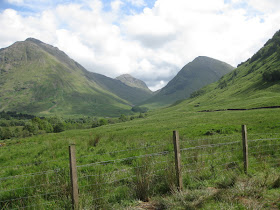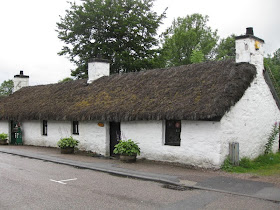July 3-5
We continue to drive through magnificent countryside in the Highlands of Scotland. The mountains are so steep we lost our GPS signal for about 30 minutes. In fact, any mountain over 3,000 feet is called a Munro. The sky is ever-changing and now I know what they mean when they talk about the light in Scotland. It comes and goes: One minute dark and brooding, with clouds so low it feels like a gray ceiling—the next open, light on light, bright and sunny. One thing is sure, I am very aware of the sky. I stepped out of the reception office at our current campground with the helpful site manager so she could point out the toilet block. It was beginning to rain and while she stood there unflinching in a short sleeve polo shirt, I was busy trying to pull up the hood of my rain jacket. Naturally, the sun was shining.

Driving from Skye, where we spent two relaxing days, we pulled over for a photo of the Eilean Donan Castle where Christopher Lampert’s Highlander (1986) and The James Bond movie The World is Not Enough (1999) were filmed. It’s not an old castle—the original was built 800 years ago but was destroyed in battle in 1719. It was rebuilt between 1912 and 1932 by the Mac Rae family as their residence.

Our current location is the Glencoe Camping and Caravanning Club site in Ballachulish. All the sites that we’ve stayed in the last week have been only €15.84 per night; it has really paid to become members. Another bonus are the shelves in each of the site reception offices, loaded with books left by other campers with prices ranging from 50p if you leave a book or £1 if you don’t; all proceeds go to a charity. We’ve picked up several over the last month, reading them and then exchanging them for another.
So far, we have seen no midges: pesky, biting insects similar to mosquitos. We’ve been warned again and again that we would find them in Skye and in the Western Highlands and that they would drive us crazy. Maybe the gale force winds and rain have kept them away….
We’re right next door to a National Trust site Visitors Center and the campground is on National Trust property. The site is pricey, £5 each, but again, our passes got us in free.
On her first visit to Scotland, Queen Victoria promptly fell in love with the country and before long she was firmly ensconced at Balmoral, the Royal residence in Scotland. From here she undertook many excursions throughout the Highlands. In her journals, which were hugely popular and did much to promote the Highlands, she admired “the stern, rugged, precipitous mountains” of Glencoe, with their “beautiful peaks and rocks piled high one above the other.” So it looks like Queen Victoria was an early blogger.

This valley is the essence of the Highlands. It even has a tragic history: In 1692, British Redcoats, led by a local Campbell commander, came to the valley, and were sheltered and fed for 12 days by the MacDonalds (whose leader had been late in swearing an oath to the British monarch). Then, the morning of February 13, the soldiers were ordered to rise up early and kill their sleeping hosts, violating the rules of Highland hospitality and earning the valley the name “The Weeping Glen.” All around us, the hillsides weep with running streams. There were three survivors, a mother, and two sons.
The nine Scots pine trees planted around the ruins commemorate the nine people who died here during the massacre. But local folklore tells of a tenth person, a young boy, who survived.
On hearing the child’s cries, the commanding officer sent a soldier back to the house to kill the boy. But face-to-face with the terrified child, he could not bring himself to carry out the act, and instead he cut off the child’s little finger, smearing his sword with blood to fool his officer that the deed had been done.
The story goes that years later, at an inn not far from here, the same soldier recounted the story of the boy and expressed his guilt for the massacre. The innkeeper turned to him, held up his hand with its little finger missing and told him he need not feel guilty, for the soldier had saved his life.
In total, 38 men, women and children, all MacDonalds, were murdered in cold blood by troops carrying out government orders. Many more died trying to escape into the freezing winter mountains.
We watched a video at the NT site and looked at information posters telling the history of the area. Remember the three survivors? One of them was twelve year old John MacDonald. Nearly 200 years later, in 1838, his direct descendant, Angus MacDonald of Glencoe emigrated to America where he became a fur trader with the Hudson’s Bay Company. There Angus met and, in 1842, married Catherine, who was part Nez Perce Indian and part Mohawk. They had twelve children including a son named Duncan.

Duncan MacDonald grew up as a Nez Perce Indian, closely related to the tribal chiefs. In 1876, another group of Indians, the Sioux, led by chief Sitting Bull had attacked and killed General Custer and many of the American cavalry at the Battle of Little Bighorn. Tensions were running high and in an effort to disassociate themselves from the troubles, many of the Nez Perce moved to Montana where Duncan MacDonald was living. In Montana, Duncan met with the Nez Perce and attempted to help them. But his efforts were in vain, for on the morning of August 9, 1877, the US army mounted a dawn attack on the Indians as they slept in their camp at Big Hole. Many men, women and children were killed. Duncan MacDonald was horrified by the turn of events and resolved to publicize an account of the Nez Perce War from the Indian perspective. In later life he spoke often of the similarity of the Massacre of the MacDonalds of Glencoe and the massacre of the Nez Perce at Big Hole.
Duncan MacDonald

We took a hike to the site of the massacre, trying hard to imagine living here at that time. All around us is forest and hills and the air is sweet.

All of this beauty and its access to the people of Scotland and visitors from around the world is due to Percy Unna who in 1935 helped to raise funds to buy the Glencoe estate when it was put up for sale by Lord Strathcona. He was instrumental in organizing an appeal to raise funds to buy the Glen. For the next fifteen years, until his death in 1950, Unna, listed only as an “Anonymous Donor”, gave generous bequests to the Trust, enabling it to safeguard some of Scotland’s most important heritage.
These houses are in the tiny village of Glencoe. What a wonderful area. On our drive through the valley, my wish came true: a pipe player by the side of the road!




The Weeping Glen


I was outside, where I listened to him play and left him a tip. When I got back into Homer, Chuck tried to start up but the battery was dead. While I steered, Chuck tried to push us into position so that we could do a jump start going down the convenient hill we were on. Two guys rushed over to help and we were soon on our way. But, we spent the rest of the day at a garage getting a new alternator which had to be delivered from another town. We are quite tired of our trials and tribulations with Homer.
Land of the hill and heather Land of the awful weather Land where the midges gather - Scotland the brave. ~ Anonymous
No comments:
Post a Comment